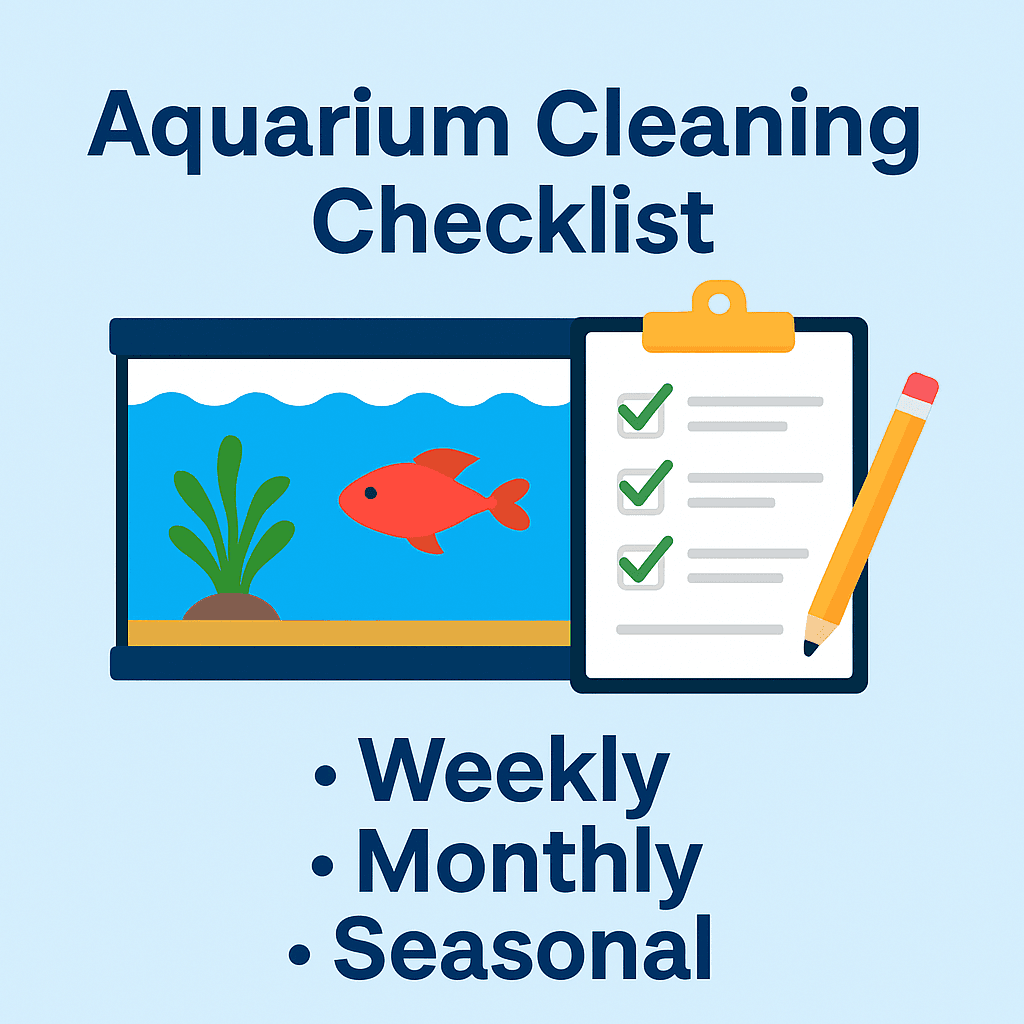
🧽 Aquarium Cleaning Checklist – Full Tank Maintenance Breakdown
Keeping your aquarium clean isn’t just about making it look good — it’s critical to the health of your fish, plants, and beneficial bacteria. Consistent maintenance prevents algae overgrowth, ammonia spikes, cloudy water, and fish stress. But many hobbyists — especially beginners — aren’t sure exactly what to do or when.
That’s why we’ve created this **complete aquarium cleaning checklist**, broken down by weekly, biweekly, and monthly tasks. Whether you’re running a 5-gallon nano tank or a 55-gallon community setup, this guide helps you stay on track and avoid costly mistakes.
📥 Free Printable Cleaning Checklist
Before we dive into the full maintenance breakdown, click below to download your printable version of the aquarium cleaning checklist. Keep it near your tank or in your maintenance bin so you never forget a step.
🧼 Why Cleaning Schedules Matter
- Water Quality: Unclean tanks lead to nitrate buildup, cloudy water, and fish illness.
- Algae Control: Regular cleanings reduce the nutrients algae needs to grow.
- Prevent Equipment Failure: Dirty filters or heaters can break down or overheat.
- Fish Health: Clean water = healthy immune systems and less stress for livestock.
🗓️ Weekly Aquarium Cleaning Tasks
These are the non-negotiables — weekly care tasks that keep your tank stable, especially in smaller or moderately stocked aquariums.
- ✔️ Test Water Parameters: Use a liquid test kit to check ammonia, nitrite, nitrate, pH, and temperature. Keep a log.
- ✔️ Change 15–30% of Water: Use a gravel vacuum to remove waste and debris from the substrate. Treat new water with dechlorinator and temperature match before adding.
- ✔️ Clean Glass/Front Panel: Use a magnetic cleaner or algae pad. Wipe inside and outside for clear viewing.
- ✔️ Top Off Evaporated Water: Use distilled or RO water to prevent rising TDS and GH/KH levels (especially for shrimp tanks).
- ✔️ Inspect Fish & Inverts: Look for signs of stress, disease, clamped fins, white spots, or hiding behavior.
- ✔️ Remove Uneaten Food: Siphon or net out leftovers to prevent ammonia spikes and algae.
🗓️ Biweekly Aquarium Tasks (Every 2 Weeks)
Biweekly tasks focus on balancing plant care, filter health, and water quality. These keep your tank from slowly drifting off balance.
- ✔️ Trim Aquarium Plants: Prune overgrowth, remove dead leaves, and replant stem cuttings for denser aquascapes.
- ✔️ Re-dose Root Tabs: If using gravel or inert substrate, place tabs near heavy feeders like swords or crypts.
- ✔️ Rinse Filter Media: Use tank water (not tap) to gently clean sponge, floss, or ceramic rings. Don’t over-clean or scrub away beneficial bacteria.
- ✔️ Wipe Down Equipment: Gently clean heaters, internal filters, air stones, and suction cups.
- ✔️ Light Maintenance: Check light schedule. Dust or clean LED light covers to prevent PAR loss.
🗓️ Monthly Aquarium Maintenance
Every 4 weeks, go a little deeper. These are the system checkups and preventative measures that help tanks thrive long-term.
- ✔️ Deep Vacuum Substrate: Focus on corners, under hardscape, and behind decor where debris collects.
- ✔️ Clean Filter Impeller: Disassemble and wipe down to prevent reduced flow or noise from gunk buildup.
- ✔️ Calibrate Heaters: Use a reliable thermometer to confirm heater accuracy. Adjust if needed.
- ✔️ Review Stocking Levels: Too many fish? Frequent deaths or algae issues may signal overstocking.
- ✔️ Clean Intake & Output Tubes: Especially for canister or HOB filters. Remove buildup that restricts flow.
- ✔️ Test GH/KH: Especially important for planted tanks or shrimp. Maintain stability to avoid plant melt or molting issues.
🧼 Seasonal or Deep-Clean Tasks (Every 3 Months)
- ✔️ Rearrange or Reset Aquascape: Remove excessive hardscape buildup, trim or replant overgrown areas.
- ✔️ Replace Light Tubes or Upgrade LEDs: For T5/T8 users, swap bulbs after 6–12 months. LEDs last longer but can lose intensity.
- ✔️ Clean CO₂ Diffuser or Bubble Counter: Mineral deposits or algae can block flow.
- ✔️ Review Fertilizer Schedule: Check plant health. Are leaves yellowing, melting, or growing slowly? Adjust dosing.
- ✔️ Inspect Airline Tubing & Valves: Replace cracked or stiff tubing. Check for CO₂ leaks.
📦 Cleaning Supplies Checklist
- 🧽 Algae pad or magnetic glass cleaner
- 🪣 Dedicated aquarium bucket (never used for soap)
- 🧪 Liquid test kits for ammonia, nitrite, nitrate, pH, GH, KH
- 🔄 Gravel vacuum or siphon
- 🧼 Filter sponge cleaning bucket
- ✂️ Aquascaping scissors & tweezers
- 💊 Dechlorinator (e.g., Seachem Prime)
- 📋 Your printed DBC Aquatics Cleaning Checklist
❌ Common Cleaning Mistakes to Avoid
- 🚫 Cleaning all filter media at once (destroys beneficial bacteria)
- 🚫 Using tap water to rinse filter sponges (kills microbes)
- 🚫 Skipping water changes because the tank “looks clean”
- 🚫 Letting algae build up for weeks before addressing it
- 🚫 Moving decor/fish during every cleaning (causes stress)
🔗 Related Tank Maintenance Guides
- Routine Maintenance Tasks Explained
- How to Clean Gravel (With & Without Siphon)
- Water Change Frequency by Tank Type
- Full Weekly, Monthly, Seasonal Schedule
📌 Final Thoughts – Consistency Over Complexity
Fish tanks thrive on routine, not perfection. You don’t need to do everything every day — you just need to stay consistent. This cleaning checklist breaks your tank’s care into manageable chunks, helping you prevent emergencies, reduce stress, and actually enjoy your aquarium more.
Don’t forget to download your printable version and hang it near your tank or maintenance area. Checking off tasks each week builds momentum and helps you catch small issues before they become big problems.